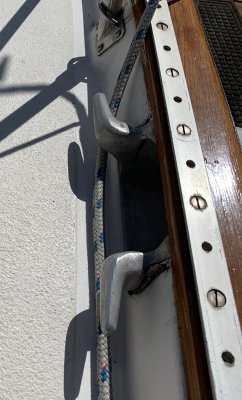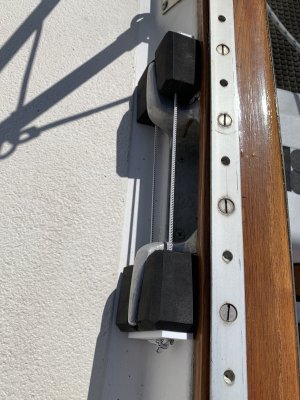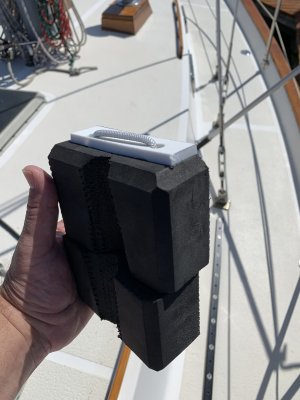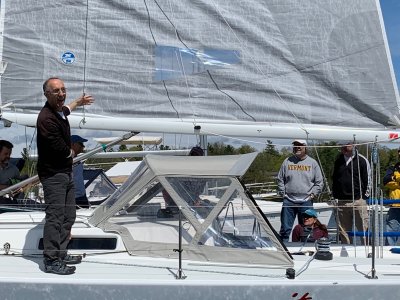Does your jib sheet ever get fouled in the midship cleat? It seems to happens to us a lot, especially in lively winds … which is precisely when you don’t want to deal with things like that. It adds stress to the captain, crew and rigging, especially when racing.

Jib Sheet Fouled in Midship Cleat
Has anyone figured out a way to avoid with this?
I came up with this invention that I’m certain is going to make me millions of dollars: Bullpads. Then the admiral will lift our spending freeze and I could afford to buy more bling for Zia.

Bullpad at Work
I made them with about $10 of materials, but I’m pretty sure I could sell a pair in West Marine for $220. They are marine grade, after all. ;-)
I used these materials:

They store very tidily in the nearby dorade box when not in use. For example, when docked.
Q: Why the name ‘Bullpad’?
A: We needed a cool nautical name that was easy to remember. My wife & I decided on Bullpads because:
Q: So shouldn’t they be named ‘Bulpads’?
A: Yeah, but that looks weird.
BTW, I think our midship cleats on the Morgan 38 are technically called ‘Hawse Pipe Cleats'. Because they are in/on a hawse pipe through the bulwark. However, ‘Hawse Pipe Cleat Pads’ is just not a cool name.

Jib Sheet Fouled in Midship Cleat
Has anyone figured out a way to avoid with this?
I came up with this invention that I’m certain is going to make me millions of dollars: Bullpads. Then the admiral will lift our spending freeze and I could afford to buy more bling for Zia.

Bullpad at Work
I made them with about $10 of materials, but I’m pretty sure I could sell a pair in West Marine for $220. They are marine grade, after all. ;-)
I used these materials:
- high density closed cell foam (fairly rigid) from a $5 yoga block I bought on Amazon. It was $10 for a pair but I used the 2nd block for other things.
- shock cord
- small rectangles of Kings Starboard on the ends to avoid the shock cord cutting into the foam. This is also what gives Bullpads their 'marine grade' rating.

They store very tidily in the nearby dorade box when not in use. For example, when docked.
Q: Why the name ‘Bullpad’?
A: We needed a cool nautical name that was easy to remember. My wife & I decided on Bullpads because:
- The cleat kinda looks like a bull’s horns, and (more technically)
- They are on the sides of the bulwark.
Q: So shouldn’t they be named ‘Bulpads’?
A: Yeah, but that looks weird.
BTW, I think our midship cleats on the Morgan 38 are technically called ‘Hawse Pipe Cleats'. Because they are in/on a hawse pipe through the bulwark. However, ‘Hawse Pipe Cleat Pads’ is just not a cool name.
Last edited:



